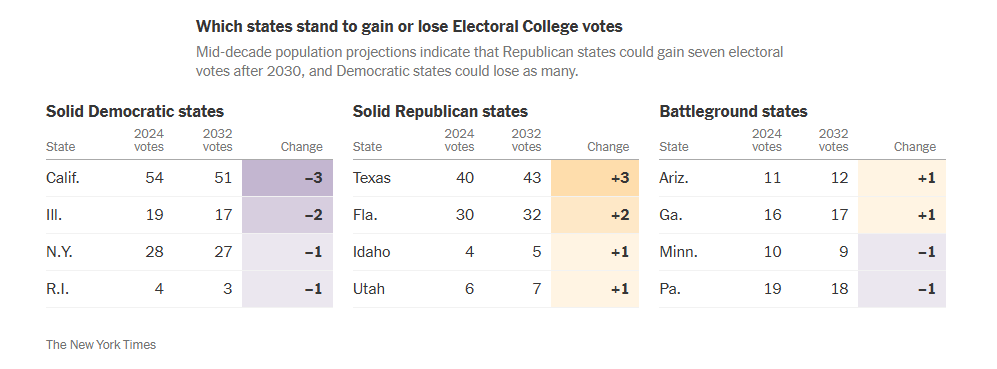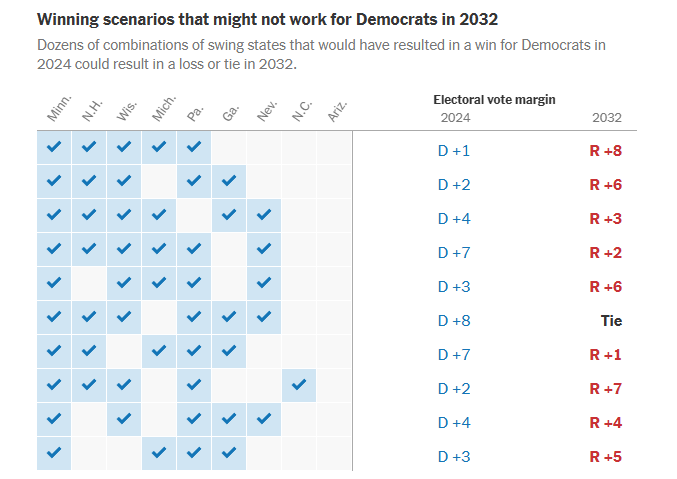Population shifts from Democratic-led states to Republican-led states are on track to reshape congressional representation and the Electoral College map heading into the next decade, according to current projections referenced by the New York Times.
The analysis indicates these trends would benefit fast-growing states such as Florida, Texas, Utah, and Idaho, while reducing seats in states including California and New York.
According to the projections, Florida and Texas are expected to gain a combined five U.S. House seats in the next reapportionment if current population patterns hold.
Trump’s Sovereign Wealth Fund: What Could It Mean For Your Money?
Utah and Idaho are each projected to add one seat.

The gains would come at the expense of states losing population or growing more slowly, including California and New York.
These are projections and will ultimately depend on final population totals at the next census and the apportionment process that follows.
The projections are separate from any potential changes to the decennial count.
This Could Be the Most Important Video Gun Owners Watch All Year
[esi random_video_player ttl=”0″]
Discussions continue over whether the census should exclude illegal aliens from population totals used for apportionment.
Depending on the estimate, illegal aliens constitute roughly 3% to 10% of the U.S. population.
Supporters of an exclusion policy argue that removing illegal aliens from the count would alter seat distribution further; any such change would require legal and administrative action and could face court challenges.
In Texas, separate from the long-term population shifts, recent redistricting approved in the state is expected by its backers to add five Republican seats compared with the current alignment.
That state-level mapmaking occurs independently of national reapportionment and would take effect within the existing number of Texas seats unless and until the state gains additional seats through the census.
The Electoral College impact described by the New York Times centers on potential changes to state vote weights and the distribution of competitive states.
Across scenarios involving nine states considered likely battlegrounds in the 2032 presidential election, the Times analysis found that Democrats would lose roughly one-third of their current winning Electoral College combinations if population projections hold.

“The year is 2032. Studying the Electoral College map, a Democratic presidential candidate can no longer plan to sweep New Hampshire, Minnesota and the “blue wall” battlegrounds of Michigan, Pennsylvania and Wisconsin and win the White House. A victory in the swing state of Nevada would not help, either.
That is the nightmare scenario many Democratic Party insiders see playing out if current U.S. population projections hold.”
When focusing on paths considered most feasible based on 2024 voting behavior, the analysis said the effect is more substantial: of Democrats’ 25 most plausible paths to victory in 2024, only five would remain under the projected 2032 landscape.
Those findings reflect how population movements influence both congressional representation and Electoral College votes, which are tied to each state’s total number of House seats plus two senators.
States gaining residents can receive more House seats and, as a result, more electoral votes; states with slower growth can lose both. Changes in migration patterns within and between states drive these adjustments from one census to the next.
The migration trends highlighted in the projections show continued net movement toward states with relatively faster job growth and lower costs of living.
Florida and Texas have led national population gains for several years, while Utah and Idaho have sustained high growth rates relative to their size.
California and New York have experienced net domestic outflows during the same period, with overall population changes affected by international migration and natural increase.
Presumably if California does this, they will galvanize the Republican states that weren’t already on board with aggressive gerrymandering.
So be it, I guess. If he does this, he’ll turn Congress even more one-sidedly Republican.
And there’s more! pic.twitter.com/MX5JP56FBq
— Crémieux (@cremieuxrecueil) August 24, 2025
Any decision to exclude illegal aliens from the census used for apportionment would interact with these trends.
Advocates of exclusion say it would shift representation toward states with smaller populations of illegal aliens and reduce representation for states with larger such populations.
Opponents argue that long-standing census practice counts all persons residing in the United States and that changing it would require significant legal justification and administrative adjustments.
The timeline for the next apportionment will follow the 2030 Census count, with updated House seat allocations applying to the congressional and presidential election cycles that follow.
State legislatures and redistricting bodies will then draw district lines within their updated seat totals, subject to federal and state law.
As population estimates are updated and legal debates over census methodology continue, both parties are assessing how prospective changes could alter congressional control and presidential pathways.
The projections cited indicate that, even without changes to who is counted in the census, expected migration patterns alone would shift seats and electoral votes toward states that have posted the strongest population gains.

![NYT Predicts 'Nightmare Scenario' for Democrats if Population Projections Hold [WATCH]](https://www.right2024.com/wp-content/uploads/2025/08/NYT-Predicts-Nightmare-Scenario-for-Democrats-if-Population-Projections-Hold-750x375.jpg)

![Steak ’n Shake Mocks Cracker Barrel Over Identity-Erasing Rebrand [WATCH]](https://www.right2024.com/wp-content/uploads/2025/08/Steak-n-Shake-Mocks-Cracker-Barrel-Over-Identity-Erasing-Rebrand-WATCH-350x250.jpg)




![Soros Network, Others Behind LA Riots [WATCH]](https://www.right2024.com/wp-content/uploads/2025/06/Soros-Network-Others-Behind-LA-Riots-WATCH-350x250.jpg)
![Human Trafficking Expert Details Horrific Biden Admin Endangerment of Migrant Kids [WATCH]](https://www.right2024.com/wp-content/uploads/2025/07/Human-Trafficking-Expert-Details-Horrific-Biden-Admin-Endangerment-of-Migrant-350x250.jpg)





